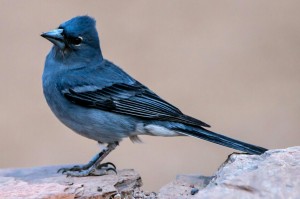Week 6 – 14 August 2016:
Europe’s Most Endangered Songbird?
Without taxonomy, there is no biological conservation. It really is that simple. We don’t enact laws to protect creatures, or gather funds for projects to help restore their numbers, until we know exactly what we are dealing with.
And therein lies the problem. Birds are the best-studied wildlife group on the planet, yet we still don’t fully understand who is related to whom; the classification of birds is in a constant state of flux. It is one of the key goals of avian biology to understand how one group of birds is related to another, and each new finding is likely to result in a change in the system of classification.
Consider the Blue Chaffinch. According to the Avibase website (http://avibase.bsc-eoc.org), this resident of two of the Canary Islands off the northwest coast of Africa is also known by the common name Teydefinch. Its two-part scientific name is Fringilla teydea, first applied to the species in 1841 by biologists Webb, Berthelot and Moquin-Tandon. Fringilla is Latin for “finch,” and teydea is a reference to Mount Teyde on the island of Tenerife.
So far so good?
In 1905, the German ornithologist Ernst Hartest subdivided the Blue Chaffinch into two subspecies on the basis of differences in size and plumage. To the birds on the island of Tenerife, he added a third component to the name, making it Fringillla teydea teydea. Members of the second subspecies, found on the island of Gran Canaria, were to be known by the three-part name Fringilla teydea polatzeki. One species – two subspecies.
Still with me?
According to the IUCN’s Red List of Threatened Species website (http://iucnredlist.org), the Blue Chaffinch should be considered “near-threatened.” The IUCN points out that the subspecies living on Gran Canaria is doing very poorly, but when combined with birds on Tenerife, the species is secure and possibly increasing in size. Laws that protect species do not necessarily apply to threatened subspecies. Consequently, the Gran Canaria form of the Blue Chaffinch might soon be lost.
Enter Swedish researcher George Sangster and four of his colleagues from the Canary Islands, the Netherlands, Portugal and the United States. For the first time since 1905, Sangster et al. reconsidered the taxonomy of Blue Chaffinches. Recognizing the value of utilizing multiple lines of evidence, they first considered differences in the plumage of the two chaffinch groups, studying stuffed specimens in museum collections. The group then recorded the calls and songs of Blue Chaffinches in the wild, and accessed archived recordings, to assess differences between the groups. They also conducted playback experiments in which songs of both subspecies were broadcast to Blue Chaffinches on Gran Canaria to determine whether they could discriminate between songs from their own island and those from Tenerife.
When combined with earlier studies of genetic differences between the groups, Sangster and his colleagues felt that differences in plumage, songs, calls, and responses to playback all pointed to the conclusion that Blue Chaffinches on Gran Canaria and Tenerife are not just subspecies, but rather are different species. Already different, they are likely to continue to diverge in the future. Given that the Gran Canaria form has a very small range (less than 20 km2; 8 square miles) and population (something like 120 individuals), and that the population has been in a long-term decline, Sangster et al. felt that Fringilla polatzeki (a full species) should be considered critically endangered and in need of immediate assistance.
When I contacted him, Sangster responded with great enthusiasm. He even supplied the photograph that accompanies this piece. He explained that he and his colleagues had known for more than a decade that the Gran Canaria population of the Blue Chaffinch was something unique and special, but waited to publish their findings until all of the necessary evidence had been collected, and that local ornithologists were in agreement with the change in status. They were also concerned that an influx of birdwatchers might damage the last bit of habitat available to the birds.
Felipe Rodríguez-Godoy added to the story, explaining that a captive breeding program for the Gran Canaria Blue Chaffinch has been in place for several years. To date 80 juvenile birds, products of the breeding program have been released. The population has been growing very slowly, and so a translocation program has been added. Some of these birds were fitted with radio transmitters so that their progress might be monitored. It will be a couple of years before the effectiveness of the translocation is known.
It is through efforts like these that the future of Europe’s most endangered songbird now looks a bit brighter.
Sangster, G., F. Rodríguez-Godoy, C. S. Roselaar, M. S. Robb and J. A. Luksenburg. 2016. Integrative taxonomy reveals Europe’s rarest songbird species the Gran Canaria Blue Chaffinch Fringuilla polatzeki. J. Avian Biol. 47:159-166.
Photocredits: photograph of a male Blue Chaffinch by Steve Kitchen, from http://birdingaxarquia2.blogspot.com.au/2016/03/the-blue-chaffinch.html; painting of Blue Chaffinches from http://www.avibirds.com/html/Blue_Chaffinch.html



